The SharePoint Accounts Payable team site template is a team site powered by Microsoft Syntex and comes with several sample pages prepopulated and preformatted to give your accounts payable team a good starting point and serve as their internal home page. The template also comes with a prebuilt tutorial and some established models and flows designed to help your team get started with Microsoft Syntex.
Note: You must be a licensed Syntex user to view and apply this site template.
Use the Accounts Payable site template so employees can manage, process, and track purchase orders, extract key information from invoices using a prebuilt invoice model, then use the preconfigured document libraries provided to store everything. Use Microsoft Syntex to organize and classify files and use the site to share important information, such as updates to agreements or new policies.
In this article, we share the elements that are on the Accounts Payable team site template and discuss how you can customize the site to make it your own.
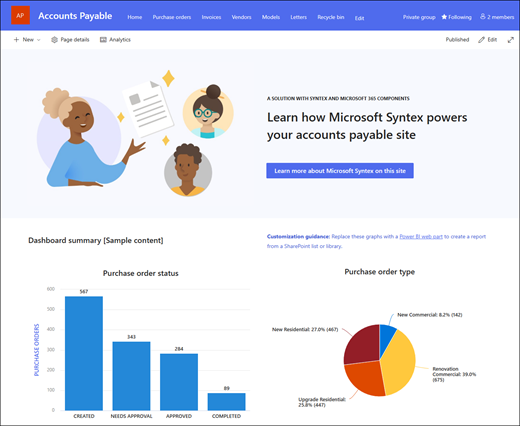
Site features
-
Customizable site that comes pre-populated with images, web parts, and content that's meant to inspire site editors when making customizations to fit the need of your team.
-
Extract key information from documents using prebuilt or custom AI models using Microsoft Syntex. Includes a tutorial to provide some ideas on how to use the site with Microsoft Syntex.
-
Enter and track existing purchase orders, invoices, and vendors and indicate their status using the provided lists or use Microsoft List to create your own.
Notes:
-
Some functionality is introduced gradually to organizations that have opted into the Targeted release program. This means that you may not yet see this feature, or it may look different than what is described in the help articles.
-
When you apply a template to an existing site, your content will not automatically merge with the new template. Instead, existing content will be stored as a duplicate page in Site contents.
First, follow instructions on how to add a site template to a new or existing SharePoint site.
Note: You must have site creation permissions to add this template to your site.
Explore pre-populated site content, web parts, and pages and decide what site customizations will be necessary to align with your organization's brand, voice, and overall business objective.
Pre-populated site pages:
-
Home page - Provides and landing for visitors where they can review the status of purchase orders and invoices, see upcoming deadlines, and access helpful resources and information on policies and procedures.
-
Purchase orders - Keep track of submitted purchase orders, their status, and accompanying vendor information.
-
Invoices – Keep track of submitted invoices, their status, amount, and accompanying vendor information.
-
Vendors – Keep track of vendors approved or pending approval along with their contact information.
-
Models - Store a library of models to extract metadata and classify information from documents using Microsoft Syntex. Comes with a preformatted model on invoice processing and receipt processing.
-
Letters - Use this prebuilt library to store and catalogue important documents.
-
Recycle bin - Provides access to recently discarded team content.
Once you've added the Accounts Payable team site template, it's time to customize it and make it your own.
Note: To edit a SharePoint site you must be a site owner or site member.
|
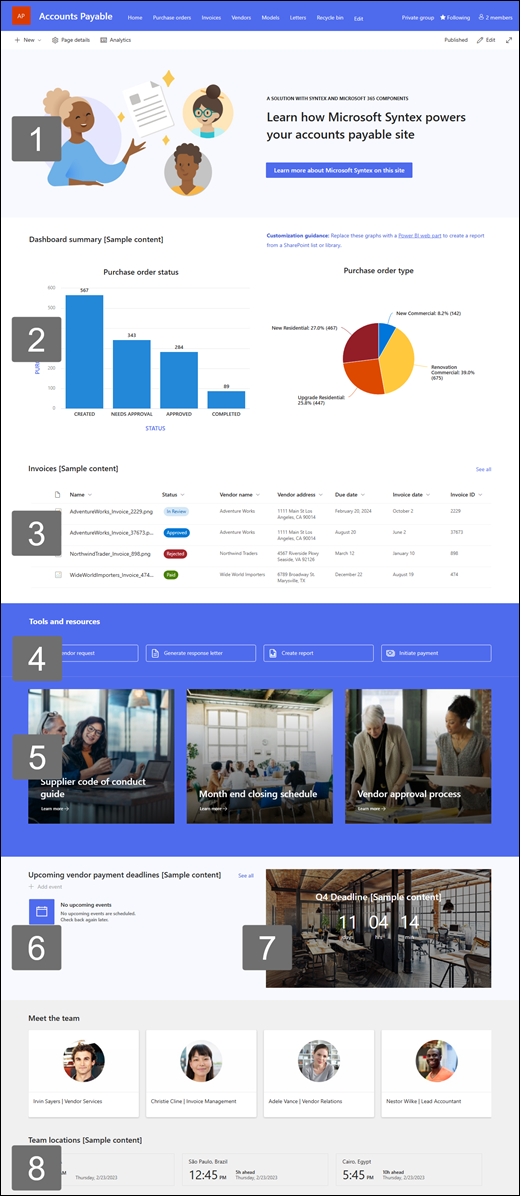 |
Customize your site's look, site navigation, web parts, and content to fit the needs of your viewers and of the organization. When making customizations, ensure the site is in edit mode by selecting Edit in the top right of the site. As you work, Save as a draft, or Republish changes to make edits visible to viewers.
1. Use the Text and Image web parts to provide engaging content

-
Begin by selecting the Text web part and select Edit web part

-
Edit your text directly in the web part.
-
Select the Image web part and choose Edit web part

-
Select Change and select an image source.
-
Once you've chosen your image, select Insert.
Learn more about editing the Text and Image web parts.
2. Use the Quick Chart web part to add simple, basic charts to your page.
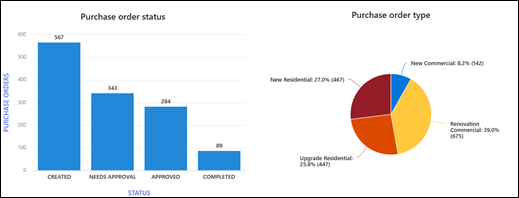
-
Begin by selecting the Quick Chart web part and select Edit web part

-
Select a chart type in the options that best suit your data.
-
In the Data section enter your data manually, or get data from an existing SharePoint list or library.
-
Continue to format your chart by setting the data points, layout, and values.
Learn more about editing the Quick Chart web part.
3. Use the Document Library web part to provide quick access to contract templates and documents

-
To change the view, or folder source for the Document library web part, select the Edit web part

-
To edit document library folders, labels, content, navigate to library in Site content, make your edits, and then you see content update in the web part.
Learn more about editing the Document Library web part.
4. Use the Quick Links web part to provide quick access to resources.

-
Select the Quick Links web part and choose Edit web part

-
Edit the link, title, icon, and description if needed.
-
To add a link, select + Add links.
See different types of layouts and editing options for the Quick Links web part.
5. Use the Hero web part to highlight important policies, updates, and other useful resources
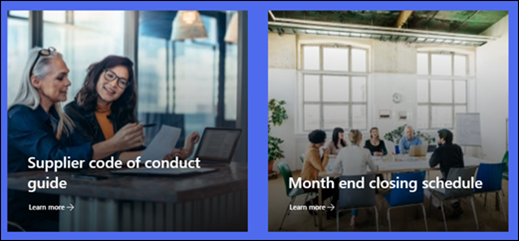
-
Begin by selecting the Hero web part and select Edit web part

-
Then, select the Layer and Tile options that best suit the organization’s needs.
See different layouts and learn more about editing the Hero web part.
6. Use the Events web part to display upcoming events.

-
Select the Events web part and choose Edit web part

-
To add or edit events in the Event web part, navigate to the Event web part and select + Add event.
Learn more about using and editing the Events web part.
7. Use the Countdown time web part to display a countdown to an event.
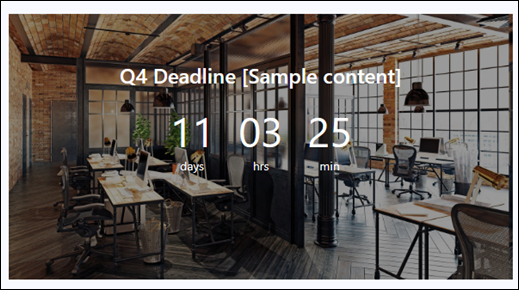
-
Select the Countdown web part and choose Edit web part

-
Enter the date and time of your event and choose your options.
-
Add a call to action link and a background image to be displayed with the timer.
Learn more about adding a countdown timer by visiting the Countdown timer web part.
8. Use the World Clock web part to show time zones from around the world.

-
After entering edit mode, Add a location.
-
Select the World Clock web part and choose Edit web part

-
Choose the date and time format and show the day of the week.
Learn more about using the World Clock web part.
Customize the following pages within the site
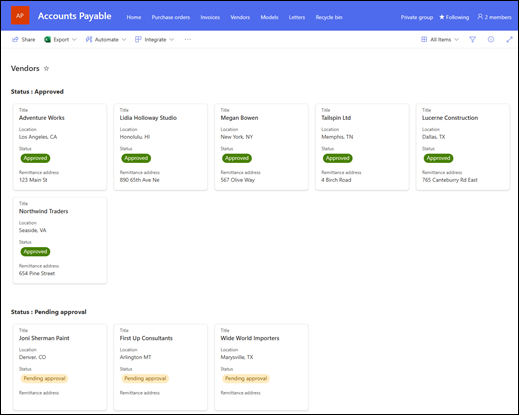
-
Purchase orders - Track submitted purchase orders between your clients and your organization. Edit the document library by updating the folder names and uploading resources.
-
Invoices - Use a provided invoice template or store custom templates that are easily accessible by the accounts payable team. Edit the document library by updating the folder names and uploading resources.
-
Vendors - Use the prebuild list to keep track of existing vendors and their status. Customize this list by editing the list template.
-
Models - Use preconfigured sample models to extract and classify information from documents. Comes with two prebuilt models. Learn more about using Microsoft Syntex here.
-
Letters - Store important documents used for communicating with vendors and within your organization. Edit the document library by updating the folder names and uploading resources.
Customize the look and site navigation
Before you share your site with others, put the finishing touches on your site by ensuring users can find the site, navigate through links and pages easily, and quickly access content on the site.
-
Edit document libraries by updating the folder names and uploading resources.
-
Edit and customize site navigation.
-
Change the look of your site by customizing the theme, logo, header layouts, and the look of your site.
-
Add or remove pages to this site or the site navigation to accommodate existing content.
-
Choose to associate this site with a hub site within your organization, or add this site to an existing hub site navigation if needed.
Microsoft 365 Group connected-team sites
For Team sites that are part of a Microsoft 365 Group, adding users to the group will give them access to the site, along with additional group resources such as calendars and conversations. You can also share the site with users without adding them to your Microsoft 365 Group. This will give them access to the site, but not other group resources such as calendars and conversations.
-
Select Settings and then Site Permissions.
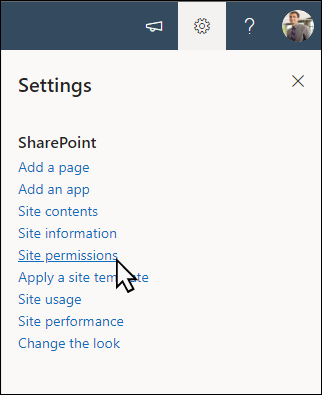
-
Select Add members then Add members to group.
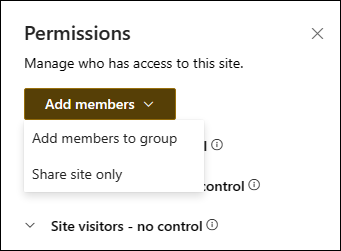
-
Select Add members.

-
Enter the name(s) of all users you want to add to the group then select their permissions (Member, Owner).
-
Select Save.
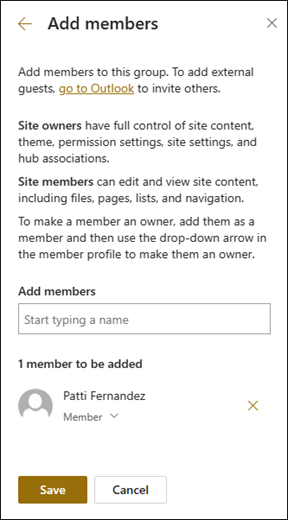
Learn more about managing team site settings, site information and permissions.
-
Select Settings and then Site Permissions.

-
Select Add members then Share site only.

-
Enter the name(s) of all users you want to grant access to site content and select their level of control (Read, Edit, Full Control).
-
Enter an optional message to send with the email notification that will be sent when the site is shared, or clear the Send email checkbox if you don't want to send an email.
-
Select Add.
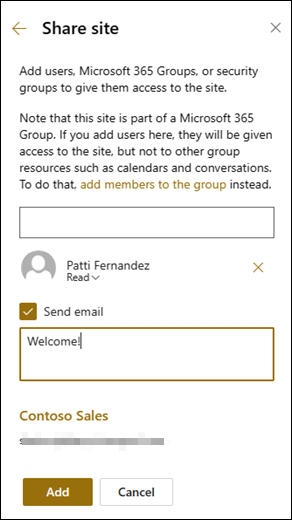
After you create and launch your site, the next important phase is maintaining site content. Ensure you have a plan to keep content and web parts up to date.
Site maintenance best practices:
-
Plan for site maintenance - Establish a schedule to review the site content as often as needed to ensure content is still accurate and relevant.
-
Regularly post news - Distribute the latest announcements, information, and status across the organization. Learn how to add a News post on a team site or communication site, and show others who will be posting announcements how they can use SharePoint news.
-
Check links and web parts - Keep links and web parts updated to ensure you are leveraging the full value of your site.
-
Use analytics to improve engagement - View site usage by using the built-in usage data report to get information on popular content, site visits, and more.
-
Periodically review your site settings - Once you've created a site in SharePoint, you can make changes to the settings, site information, and permissions for the site.
More customization resources
Learn more about planning, building, and maintaining SharePoint sites.
See more SharePoint site templates.










